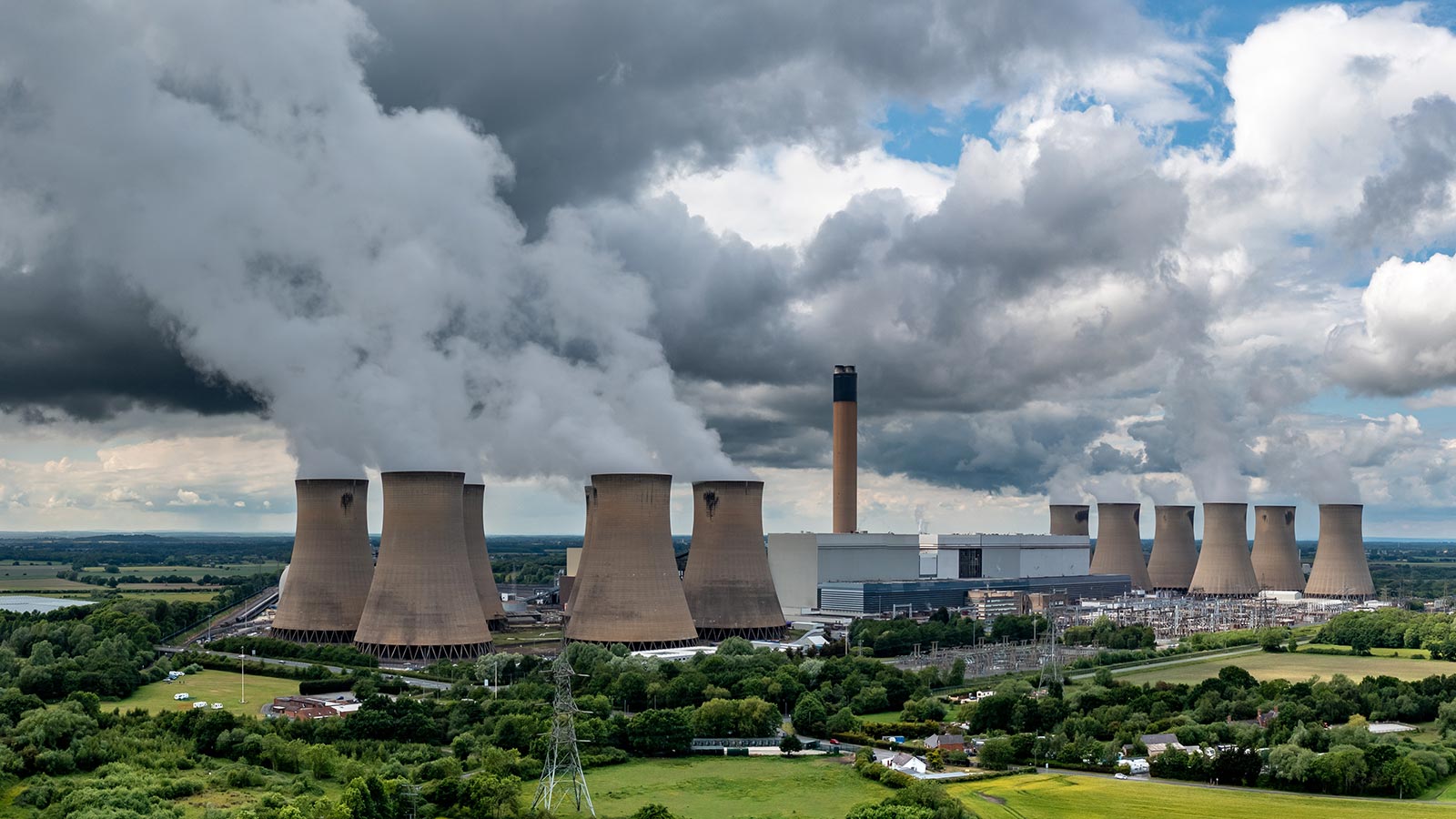Accounting for Carbon Capture and Sequestration
Never miss a thing.
Sign up to receive our Tax News Brief newsletter.

Carbon capture and sequestration (CCS) has emerged as a key element in efforts to address climate change. By capturing CO2 emissions directly from sources or from the atmosphere, compressing it, and injecting it deep underground into geological formations, CCS provides a way to effectively reduce the impact of CO2 emissions on the environment.
With tax credits and other incentives in the Inflation Reduction Act, the urgency to accelerate CCS deployment has intensified, especially within heavy industries like power generation, cement production, and steel manufacturing. These new projects come with new accounting considerations that should be top of mind at the outset of every project.
The oil and gas industry has used carbon capture technology for over 50 years to enhance oil recovery from developed fields and has developed the subsurface expertise and technical capabilities to identify, characterize and develop significant CCS projects. The industry’s decades of experience and technical expertise uniquely position the industry play a key role in accelerating the development of large-scale CCS projects that can meaningfully reduce CO2 emissions.
However, despite this progress, accounting for CCS projects remains a nuanced challenge, especially concerning lease considerations under ASC 842. This article aims to illuminate these complexities, starting with the evaluation of carbon sequestration agreements and their alignment with ASC 842 – Leases.
Background
Carbon capture and sequestration (CCS) refers to a set of technologies designed to combat climate change by reducing carbon dioxide (CO2) emissions. CCS involves capturing CO2 directly at the emission source or indirectly from the atmosphere. The captured CO2 is compressed and transported to an injection site where it can be stored in a geologic formation deep underground.
Accelerating deployment of carbon capture technology will be essential in reducing emissions from power plants and other heavy industries (e.g., cement plants and steel manufacturing, etc.). The importance of accelerating deployment CCS technology is underscored by the enactment of the Inflation Reduction Act, which increased the value of 45Q credits for industrial and power plan carbon capture as well as the credit for direct air capture.
Historically, companies in the oil and gas industry have accounted for carbon capture technology related to enhance recovery from existing oil and gas reservoirs under the successful efforts method of accounting prescribed by ASC 932 Extractive Activities – Oil and Gas or under the Full Cost accounting method prescribed by SEC’s Regulation S-X Rule 4-10.
CCS projects, however, are not associated with the extraction of hydrocarbons and do not fall under the Successful Efforts or Full Cost accounting methodologies. This can create uncertainty about how to account for certain aspects of the activity.
CCS Contract and Agreement Overview
Carbon capture and sequestration agreements generally convey the surface and subsurface rights necessary to allow the lessor to build a carbon capture and sequestration system to store carbon dioxide in a geologic formation below a landowners property for a specified period of time. Although the specific terms of the agreement can vary from one agreement to another, the agreements typically convey the following rights to the lessor:
- Carbon Dioxide Storage Rights: The exclusive right to geologically store carbon dioxide in a “reservoir area” (geologic stratum, formation, aquifer, cavity, or pore space) in a designated area below a landowner’s property. The reservoir area used for carbon capture and storage is typically thousands of feet below the surface and is not inhabited or generally accessible.
- Surface Use Rights: The right to use surface acreage for the construction and installation of carbon capture and sequestration facilities. This can include injection, storage, midstream, pumping or other facilities and equipment deemed necessary for the sequestration of carbon dioxide. The installation of a well pad or other facilities prevents others from utilizing the underlying acreage for the contract period. The portion of the surface utilized for the installation of facilities is generally a very small portion of the leased acreage.
- Surface Access Rights: The right to access the property to construct, install, operate and maintain the carbon capture and sequestration facilities over the life of the project. Generally, the land owner retains the right to access or use the property for any purpose as long as it does not interfere with the CCS company storage rights. As such, the CCS company does not have exclusive use of the underlying surface acreage related to these rights.
Topic # 1 Lease Considerations and Scope
The first step is to determine whether the agreement is within the scope of ASC 842. ASC 842 defines a lease “as a contract, or part of a contract, that conveys the right to control the use of identified property, plant, or equipment (an identified asset) for a period of time in exchange for consideration”. Additionally, ASC 842-10-15-1excludes: i) lease of intangible assets; ii) lease to explore for or use minerals; iii) lease of biological assets; iv) lease of inventory; and v) lease of assets under construction.
CCS agreements grant subsurface rights to geologically store anthropogenic carbon dioxide in pore space of a reservoir in a geological formation thousands of feet below the surface of the leased property. The subsurface acreage associated with the storage right cannot be inhabited or accessed by humans; therefore, lacks physical substance and is considered to be more akin to an air use right. As such, right to use the inaccessible subsurface acreage is outside the scope of ASC 842 and will be accounted for pursuant to the guidance in ASC 350 – Goodwill and Intangible Assets.
Although the subsurface rights are considered out-of-scope, CCS Agreements typically convey the right to use, access or cross the surface land located above the formation (i.e., land easement) for the construction, installation, maintenance and operation of pipelines, meters and related equipment for the transportation of carbon dioxide from its source to the injection site for the life of the agreement. With the exception of land easements deemed perpetual, the rights to use surface acreage are not excluded from the scope of ASC 842 and require further assessment.
Topic #2: Does the agreement include any identifiable assets?
The next step is to determine whether the agreement is or contains a lease by assessing both of the following: i) whether there is an identified asset; and ii) whether the contract conveys the right to control the use of the identified asset in exchange for consideration for a period of time. To meet the definition of an identified asset, an arrangement must require use of an explicitly or implicitly identified asset that is physically distinct.
The agreements typically convey the right to exclusively utilize a portion of the surface acreage for the installation of carbon capture and sequestration facilities and other infrastructure necessary to transport the carbon dioxide from project inlet to the injection site. In addition, the agreements grant the non-exclusive right to access the property to construct, install, operate and maintain the carbon capture and sequestration facilities over the life of the project.
Typically, each of these surface rights are explicitly identified within the agreement and considered physically distinct. In addition, these agreements do not typically provide the Grantor with substantive substitution rights. As such, the both the exclusive use and non-exclusive surface use rights granted to the lessor are considered identifiable assets and require further analysis.
Topic #3: Are the identifiable assets considered leased assets?
Once the identified assets have been identified, the next step is to determine whether a contract conveys the right to control the use of the identified asset for a period of time. To perform this assessment, assess whether, through the period of use, the Company has both the following: i) the right to obtain substantially all of the economic benefit from the use of the identified asset; and ii) the right to direct the use of the identified asset.
With respect to the surface assess rights, the agreements typically contain a provision that allows the Grantor to retain rights to use the surface of the property for any purpose other than for the rights granted to Grantee. As a result, the lessee does not have exclusive use of the surface acreage; therefore, does not have the right to obtain substantially all of the economic benefit from the use of the identified asset or the right to direct the use of this portion of the surface acreage over the life of the lease. Therefore, the non-exclusive use of the surface acreage associated is not considered a leased asset.
When considering the right to use of a portion of surface acreage for the construction and installation of CCS facilities (e.g., meters, wells, fixtures, etc.) necessary for the sequestration of carbon dioxide, it is important to note that the facilities are permanently affixed to the portion of the surface acreage which prevents other parties from utilizing the surface during the period of use and effectively grant the lessee the exclusive use of the underlying surface acreage. The lessee has the ability to: i) direct how this identified asset is used; and ii) obtain substantially all of the economic benefit from the asset. The exclusive use of surface land represents a leased asset which must be further evaluated pursuant to the guidance in ASC 842.
Topic #4: Contract Consideration
Once all the components of the agreement have been identified, the next step is to determine the consideration in the contract. Pursuant to 842-10-15-35, the consideration in the contract for a lease includes all of the payments described in paragraph 842-10-30-5, as well as any fixed payments, less any incentives paid or payable to the lessee, other than those included in 842-10-30-5 and any other variable payments that depend on an index or a rate.
Typically, the consideration to a landowner or grantor includes these components;
- lease bonus,
- annual rental, and
- a royalty payment based on the metric tons of carbon dioxide sequestered.
When agreements are structured in this manner, the royalty payments are considered variable lease payments. In determining consideration in a contract, ASC 842-10-30-6 states “Lease payments do not include any of the following: a. Variable lease payments other than those in paragraph 842-10-30-5(b).
As the variable lease payments under the agreements are based on volumes of stored carbon dioxide and not fixed to an index or rate, they do not qualify under the stated inclusion items in ASC 842-10-30-5(b), and are therefore not included as part of lease consideration. Any payments under the agreement that do not qualify as variable lease payments need to be assessed for potential recognition under ASC 842.
Topic #5: Allocation of lease consideration:
The guidance in ASC 842-10-15-33 requires that contract consideration be allocated to the various lease and non-lease components based on a relative standalone price basis. As discussed above, the agreement contains one lease component related to the exclusive use of surface acreage for the construction and instillation of CCS facilities and multiple non-lease components (i.e., Carbon Capture and Storage Right and Surface Access Rights).
The guidance requires that a lessee determine the relative standalone price of the separate lease components and nonlease components on the basis of their observable standalone prices. If observable standalone prices are not readily available, the lessee shall estimate the standalone process, maximizing the use of observable information. A residual estimate approach may be appropriate if the standalone price for a component is highly variable or uncertain.
The determination of the standalone price for the lease component (i.e., exclusive use of surface for CCS facilities) is relatively straight forward; however, estimating the standalone price for the primary non-lease component (i.e., subsurface right to store carbon dioxide) may be challenging. The carbon capture and sequestration business is in its infancy and the price associated with the right to geologically store carbon dioxide is highly variable; therefore, it may be difficult to obtain sufficient observable information to estimate the standalone price and a residual estimate approach may be necessary. Generally, the majority of the contract consideration is attributed to the subsurface rights for the carbon dioxide storage and sequestration or the non-lease component.
Conclusion
While subsurface rights for CCS projects fall outside ASC 842’s scope and find a home in ASC 350, surface rights pose intricate considerations within lease frameworks. The delineation of identifiable assets, the determination of leased assets, and the allocation of lease consideration underscore the need for a nuanced approach in accounting practices for CCS agreements.
With observable standalone prices often elusive, estimating the value of these components demands a judicious blend of expertise and adaptability. Ultimately, as CCS technology evolves and gains prominence, so too must accounting standards evolve to effectively capture and reflect the economic and environmental dynamics of this transformative era.
For more information about accounting for CCS technology, contact us. We are here to help.
©2024

